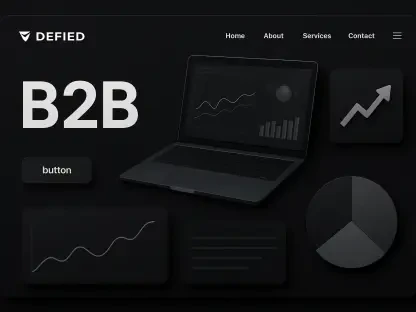In the ever-evolving digital landscape, video marketing has solidified its position as the most powerful tool for digital marketers. In 2025, it is projected to be the undisputed king of digital engagement, due to shifting consumer preferences, rapid technological advancements, and the increasing popularity of short-form and interactive video content. The landscape has been dramatically shaped by audiences’ growing inclination towards visual formats over text, propelling video marketing to the forefront of digital strategies. Businesses that fail to adapt to this shift may find themselves lagging behind in the competitive market space.
Increasing Dominance of Video Content
Consumer preferences have significantly shifted towards video content, with an impressive 80% of consumers favoring video over text when learning about products or services. This trend highlights the growing inclination towards visual content, which is more engaging and easier to consume. Video content not only excels in capturing attention but is also projected to account for over 80% of all internet traffic by 2025, according to Personify. This dominance can be attributed to the unparalleled engagement potential of videos. They can convey complex information quickly and effectively, making them ideal for today’s fast-paced digital environment.
Beyond just capturing attention, the emotional connection that videos can create through visuals, sound, and storytelling makes them powerful tools for brands aiming to build deeper connections with their audience. The layers of engagement offered by videos – visual appeal, auditory stimulation, and narrative – are instrumental in engendering a more profound emotional response. Thus, it’s no surprise that video marketing is poised to become an integral part of digital strategies. Brands are increasingly leveraging this medium to not only inform but also engage and connect with consumers on a personal level.
Driving Factors Behind Video Marketing’s Rise
Several factors are accelerating the rise of video marketing. Consumer habits have evolved, with short-form video content on platforms like TikTok, Instagram Reels, and YouTube Shorts becoming increasingly popular. These platforms cater to audiences seeking quick, engaging clips that fit into their busy lifestyles. The allure of fast-paced, bite-sized content is undeniable, particularly in an era where attention spans are shorter and the appetite for instant gratification is more pronounced. These platforms have adeptly capitalized on this behavioral shift, nurturing a culture where short-form videos thrive.
Technological advancements have also played a crucial role in this evolution. The widespread availability of high-speed internet and smartphones, coupled with user-friendly and affordable video editing tools, has empowered businesses of all sizes to produce professional-quality videos. This democratization of video production has leveled the playing field, enabling smaller enterprises to compete with industry giants. Additionally, social media algorithms favor video content, ensuring that video posts are more visible in users’ feeds and thereby increasing engagement and reach. This inherent advantage of video content within the social media landscape further underscores its rising dominance.
Types of Video Content Thriving in 2025
Short-form videos have become a staple in digital marketing. Platforms like TikTok and Instagram Reels have popularized videos under 60 seconds, which are perfect for capturing attention quickly. For instance, a clothing brand might showcase a short transformation video that blends creativity with product promotion, effectively harnessing the power of brief but impactful content. The concise nature of these videos caters to modern consumers’ preference for quick, digestible information, making them a crucial component of any robust digital marketing strategy.
Live streams are also gaining popularity due to their ability to offer real-time interaction. They build authenticity and immediacy, making them ideal for product launches, Q&A sessions, and behind-the-scenes content. The inherent spontaneity and genuine nature of live streams resonate with audiences seeking real, unscripted experiences. On the other hand, interactive videos are on the rise, allowing viewers to make choices or explore within the video, enhancing engagement with a personalized experience. For example, a beauty brand might create an interactive video that allows users to select their skin type for tailored product recommendations, providing a highly engaging and customized viewing experience.
Strategic Implementation of Video Marketing
Understanding the target audience is crucial for creating relevant videos that resonate. Knowing the audience’s demographics, preferences, and pain points helps in crafting content that appeals directly to them. This deep understanding enables businesses to produce videos that not only capture attention but also address specific needs and desires, thereby fostering a stronger connection with the viewer. Videos that focus on storytelling rather than just selling are more impactful. By conveying a brand’s personality, values, or mission, storytelling enhances memorability and emotional engagement, turning passive viewers into active brand advocates.
Mobile optimization is another critical aspect of effective video marketing. With most video content consumed on mobile devices, ensuring that videos are optimized for smaller screens is essential. This includes using vertical formats, ensuring quick load times, and adding subtitles for those watching without sound. Mobile-friendly videos are more likely to be shared, further amplifying their reach. Additionally, tracking metrics like views, watch time, engagement, and conversion rates is vital for evaluating the effectiveness of video campaigns. Analyzing these metrics allows businesses to refine their strategies and continually improve the impact of their video marketing efforts.
Challenges in Video Marketing
Producing high-quality video content can be resource-intensive, presenting a significant challenge for many brands. The need for professional equipment, skilled personnel, and substantial time investment can strain resources, especially for smaller enterprises. Brands must find a balance between quality and efficiency to sustain their video marketing efforts over the long term. Market saturation is another challenge, with the increasing ubiquity of video content making it difficult for brands to stand out. In such a crowded marketplace, creativity and originality become paramount to capture and retain audience attention.
Rapid changes in platforms and formats necessitate agility and adaptation in video marketing strategies. The constantly evolving digital landscape requires brands to stay updated with the latest trends and technologies, which can be both time-consuming and resource-intensive. Staying relevant in this dynamic environment demands continuous learning and adaptation. Brands that manage to navigate these challenges successfully can leverage the full potential of video marketing to achieve their business goals, while those that fail to adapt may find it challenging to maintain their competitive edge.
Future Trends in Video Marketing
Artificial intelligence (AI) is set to revolutionize video production, making it easier to create personalized, dynamic content at scale. AI-driven content creation will streamline the production process, allowing for more efficient and effective video marketing. From automated editing to personalized content recommendations, AI can significantly enhance the quality and relevance of video content, providing a competitive edge to early adopters. Augmented reality (AR) and virtual reality (VR) are also enhancing video experiences, offering immersive interaction opportunities for customers. These technologies allow brands to create interactive, multi-sensory experiences that can captivate audiences and provide deeper engagement.
Shoppable videos are becoming more common, integrating e-commerce and video content to enable viewers to make direct purchases from within the videos. This seamless blend of entertainment and shopping enhances the user experience and drives conversions, making shoppable videos a game-changer for e-commerce brands. The convenience of shopping directly from a video caters to modern consumers’ preference for hassle-free shopping experiences. As these technologies continue to evolve, they will provide even more innovative ways for brands to engage with their audiences and convert viewers into loyal customers.
Final Thoughts
In the continuously evolving digital realm, video marketing has cemented itself as an unrivaled tool for digital marketers. By 2025, it is anticipated to stand as the undisputed leader of digital engagement. This growth is driven by shifting consumer behavior, rapid technological advancements, and the surging popularity of short-form and interactive video content. Audiences are increasingly favoring visual content over text, which has propelled video marketing to the forefront of digital strategies. As consumers show a clear preference for video over textual content, businesses that resist this shift risk falling behind in the competitive market landscape. Therefore, to stay relevant and maintain a competitive edge, companies must adapt to these trends. Embracing video marketing is becoming essential for engaging customers and fostering brand loyalty. As the digital landscape continues to advance, those who fail to leverage the power of video may find themselves struggling to capture their audience’s attention and ultimately, their share of the market.









